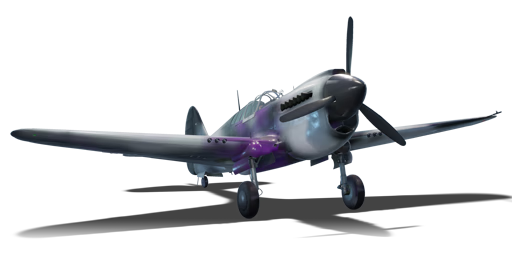

The P-40E-1 TD is a gift American fighter. It was introduced during Update "New Power" as a reward for watching War Thunder streams on Twitch.tv along with a unique skin for the vehicle.
The P-40E Warhawk is an excellent "boom-n-zoom" fighter/bomber, however, it is not limited to this kind of warfare. It is equipped with 6 x M2 Browning .50 cal machine guns which are remarkably effective against light pillboxes, some light tanks/AAA, and of course, planes. The P-40 can also equip bombs to round itself out as a decent low-rank fighter bomber.
Any competent realistic battle Warhawk flyer will tell you that it is only good at Medium altitudes (3,000 m is normally considered that middle altitude). This is because the engine's performance is poor at higher altitudes, unlike its future successors- the P-51 and P-47. The P-40's main asset is its straight-line speed- it will easily outrun Bf 109s, A6Ms, and some "modernized" biplanes you may see at its 2.3 battle rating. Head-ons are almost never advisable, but given the high velocity and fire rate of the .50 cals, lightly armoured planes such as the A6M can be taken head-on from a distance.
Otherwise, use the high speed and decent engine performance at low altitude to out-speed and energy-fight enemy planes. At high speeds, the P-40 can out-turn a select few Axis and British fighters, including some lower-rank Bf 109s and Hawker Hurricanes. Never attempt to turn with Zeros, He 112s, Spitfires or low-rank Soviet fighters as they will almost always have the turn advantage and get the better angle of attack.
In short, the P-40 is one of the best performing low-rank US planes due to its high speed and general performance which outmatches most, if not all, opponents at the 2.3 battle rating.
flaps
flaps
flaps
brake
| Belt | Belt filling | Armor penetration (mm) at a distance: | |||||
|---|---|---|---|---|---|---|---|
| 10 m | 100 m | 500 m | 1000 m | 1500 m | 2000 m | ||
| T/Ball/I/AP | 30 | 27 | 20 | 13 | 9 | 6 | |
| AP/AP/AP/T/I | 30 | 27 | 20 | 13 | 9 | 6 | |
| T/AP/AP/AP | 30 | 27 | 20 | 13 | 9 | 6 | |
| T/T/T/AP | 30 | 27 | 20 | 13 | 9 | 6 | |
| AP/I/AP | 30 | 27 | 20 | 13 | 9 | 6 | |
2 × 100 lb AN-M30A1 bomb












Flight performance | |
|---|---|
Survivability |
|---|
Weaponry | |
|---|---|